Keyword research is all about working out what someone would type into Google to find your services. It’s about planning which page to direct them to for each search phrase or keyword.
How many services do you have? What different customer groups do you have? Would they all type in the same thing? How do you choose which keywords to try to rank for on each page?
You probably need to use a keyword tool such as SEMrush, Ahrefs or SpyFu. You could also use the free keyword tool from Google—you’ll need a Google Adwords account to access it.
One good reason to do keyword research
Starting your keyword research
So how do you start your keyword research? Let’s first think about the sorts of phrases (or keywords) that your customers might use to find your services.
Imagine you were selling grass seed, your customers might type in any of these to try to find your site:
Grass seed
Sowing grass seed
Grass seed uk
Best grass seed
How long does grass seed take to grow?
Grass seed spreader
When to sow grass seed
You can see that some of these phrases indicate a user intent to purchase, such as ‘grass seed’ and some show the user is looking for information, such as ‘how long does it take for grass seed to grow?’.
There is a name for the longer, more intentional search query, and unsurprisingly it is a ‘longtail keyword’.
Keyword difficulty versus search volume
To choose your keywords, you need to check firstly what the monthly search volume is for that keyword. This is the number of unique searches that are done in your search engine, per month.
The second thing you need to consider is how hard it will be to rank, this is denoted by the keyword difficulty. This is a measure of how hard it would be to rank for that keyword, based on a number of factors, including the domain authority of other sites trying to rank on SERPs (Search Engine Results Pages).
But how do you check these two statistics for each keyword? You need to use a keyword research tool.
There are a range of keyword tools you can try, some are free, like Google Keyword Planner, and some you pay for, such as Ahrefs, KW Finder, SpyFu, SEMrush, Moz. The ones you have to pay for often have really handy features, which help you organise your keywords and allow you to check competitor information relating to a keyword.
A quick look at SEMrush enables us to see the amount of search volume a keyword attracts, and it will also give an indication on how hard it would be to rank for that keyword. It’s important to note that all keyword tools use their own scale for keyword difficulty, so a keyword difficulty score in one tool is not necessarily equivalent to a keyword difficulty score in another.
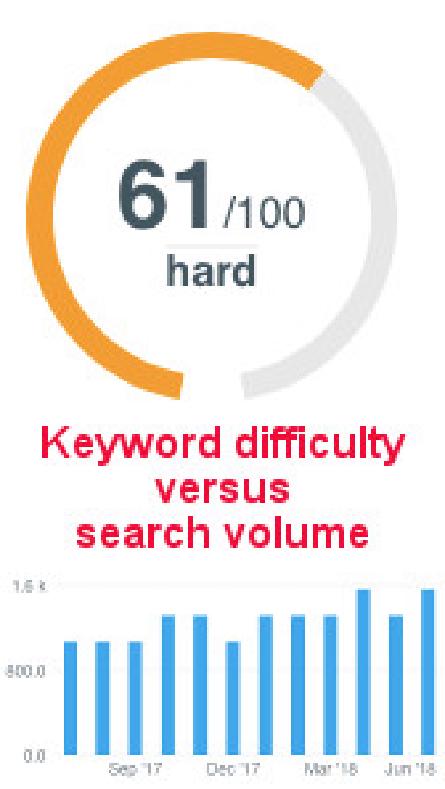
For our grass seed example, we can look in SEMrush to check the keyword difficulty versus search volume for each of the search terms. This quick check reveals that there is value in going after the traffic for both types of keyword (short and longtail keywords), as explained below.
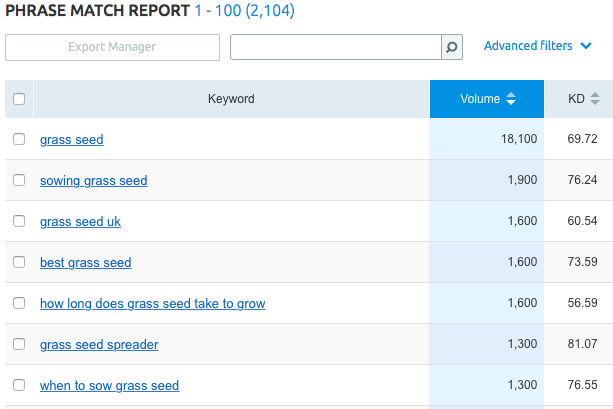
Choosing your focus keyword
Your focus keyword for a page is just that, the main keyword that you want to rank for on a particular page. Think of the focus keyword as the main topic of the page. You need to choose a keyword with a reasonable search volume but one that is achievable for the current domain authority of your site.
So in our grass seed example above, which of these keywords should you optimise your page for?
It is tempting to go for ‘grass seed’, with its extremely high search volume of 18,100, but if your site has low domain authority, it could be quite hard to rank on the top SERPs pages with this term. Anything with Keyword Difficulty of over 80 is not worth trying to do for most sites, it’s just too hard to achieve good results. Medium difficulty is a Keyword Difficulty of between 60 and 80%, and getting on the first page for a medium difficulty keyword won’t be easy unless you have strong domain authority.
So when starting out, it is best to try for keywords which are of high volume (over 1000) and under 60 KD.
We can see that ‘grass seed uk’ has a search volume of 1,600 and Keyword Difficulty of 60.54, so is definitely worth a try—it’s so nearly in the easy Keyword Difficulty range and the volume is strong.
But you need more than just your focus keyword, you need a bunch of related keywords which give you a framework to build an informative page about the topic of the page.
There are a number of considerations at this point, not least, what your competitors are ranking for and with what. More about that later on.
It is useful to build your related keywords using a mixture of short and longtail keywords.
What is a longtail keyword?
The longtail keywords are often in the form of a question, a longer phrase. The customer has a specific need or query and is looking for a website which can provide a helpful answer.
Often there is less search volume but you can be rewarded with a higher click through rate (CTR). This means more people will click on your SERPs listing because they are further down the buying funnel once they are forming questions about the subject.
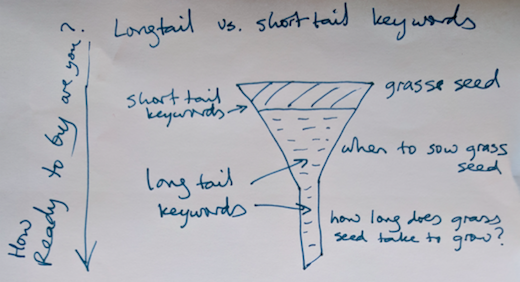
Let’s look a bit closer at longtail keywords and how including them in your content can help bring in more traffic.
From the phrase match report above, you can see the term, ‘how long does it take grass seed to grow’. It has volume of 1,600 and Keyword Difficulty of 56.59, so would be reasonably straightforward to try to rank for it.
But you might be thinking, “I want to sell grass seed, not give advice”. But if you wrote a blog piece about growing grass seed, you could pick up this traffic and point them in the direction of the buying page, once they have read the blog post.
How to rank highly in SERPs
As part of your keyword planning, for each page of your site, you need to research possible keywords and set your priorities about which keywords you will try to rank for initially on Search Engine Results Pages (SERPs).
In preparing your list you will uncover topics for potential blog pieces, but you need to make sure they are popular searches and relevant to your proposition.
One way of checking the value of a keyword is to type it into Google and see if it reveals an answer snippet, which shows it’s a popular question.
For example, this is what shows when you type in ‘grass seed when to sow’:
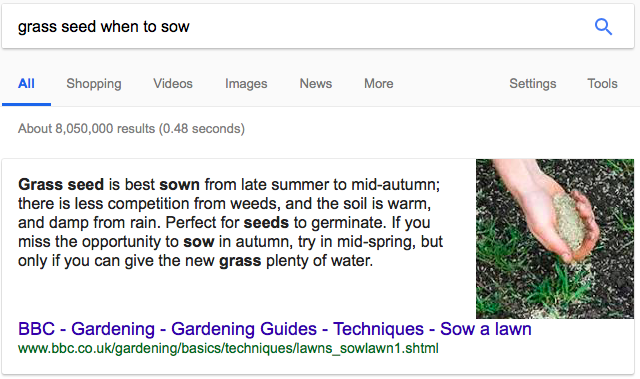
For very popular searches, you can see a series of questions that ‘people also ask’ just below the first snippet. Here’s what showed up on my search:
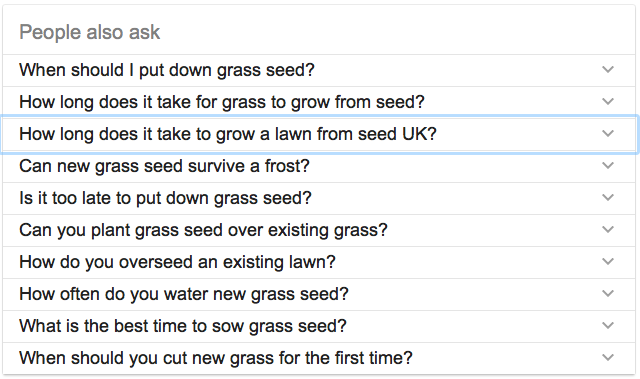
How can you use the ‘people also ask’ section with your keyword planning?
Firstly, you can have a look at the answers and try to spot where a question has not been properly answered for the average user. As long as it is relevant for your proposition to be talking about this, it could form an H2 (sub-heading of a section) for a paragraph in your forthcoming blog post.
Continue drilling down to get a handful of questions that you will answer in your blog post.
How to take organic traffic from the competition
We have talked about how to use keyword tools to find keywords with achievable keyword difficulty with reasonable search volume. This is a good start to your keyword resesrch for your keyword planning, but this is not enough to get you ranking on SERPs.
You need to check what your competitors are ranking for and make sure you devise some original content which uses the same (or similar) keywords in your website. If you’re not ranking for the keywords that your competitors are ranking for then you are not in the same game and you will lose traffic to the competition.
Once you have an idea of the best keywords in terms of search volume versus keyword difficulty, then it’s time to delve into the competitor analysis.
Finding competitive keywords
Firstly you need to pick one of your high volume, low keyword difficulty keywords you found in your keyword research earlier and put it into Google search to see which competitors are ranking organically.
Let’s look at our previous grass seed example and choose ‘grass seed uk’. Let’s go ahead and type ‘grass seed uk’ into Google now …

And scroll down to the first organic results in the SERPs, which looked like this …
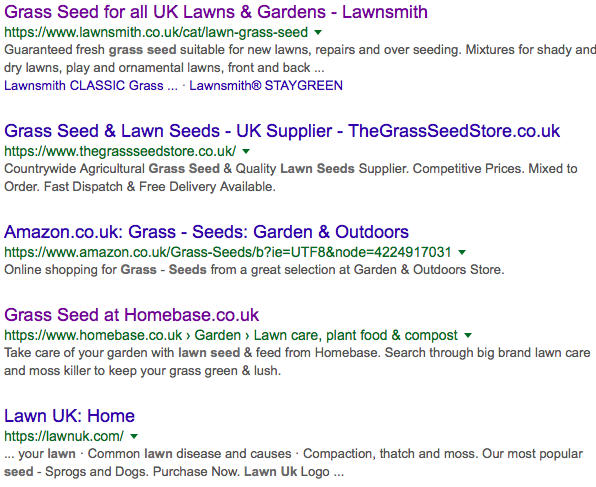
The idea is to pick the top three domains for this particular keyword (grass seed uk). Let’s not pick Amazon or Homebase as they are going to dominate the picture. Instead, let’s choose the three who are actually similarly unknown in the field of grass seed:
Next thing to do is to go back to those keyword tools, specifically to their competitor analysis sections. I like to use SpyFu for this because they have a competitor analysis tool called Kombat where you can compare up to three competitive websites and they show you the common keywords all three sites are ranking for. Very handy.
Here’s what it looks like when you pop these three domains into Kombat:
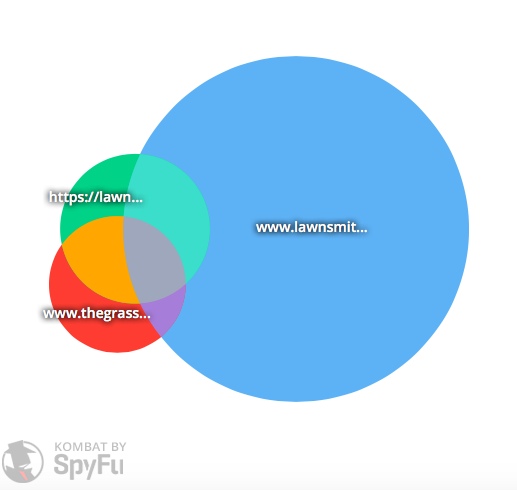
OK, so what does this all mean and how do we use this information?
Well the first place to look is the grey section in the diagram, which is the cross-over where the three websites share a number of common keywords. For you to rank alongside these websites, a good place to start would be to look at these keywords and choose the ones you think are achievable (low enough keyword difficulty).
For our example, here is the list of keywords that these three websites share:
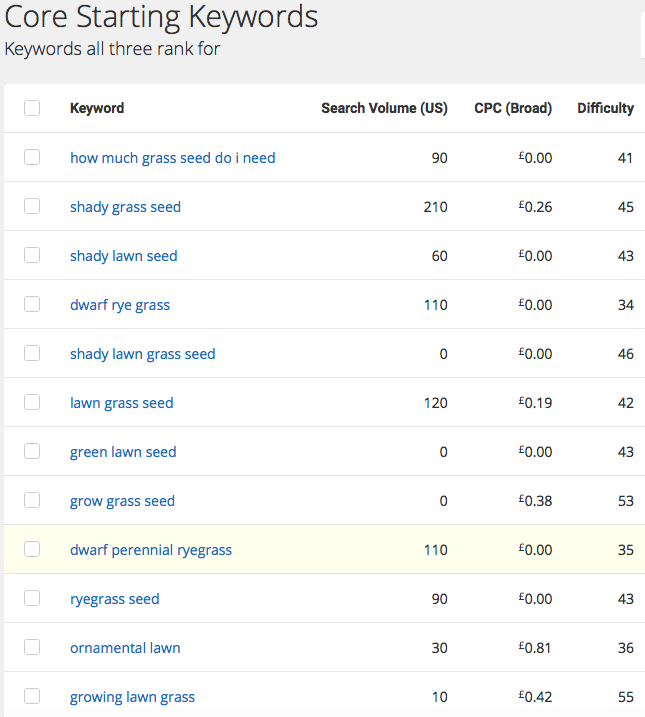
Building your keyword list
The process outlined above will give you some keywords which don’t fit easily into your new landing page. Don’t try to force it, or your content could become convoluted and confusing, and this could lead to a Google penalty.
Instead, you should group your keywords into topics, each of which could form a new landing page.
Each time you choose your focus keyword, follow the process outlined above to find new related keywords and check the competition for the new focus keyword to see what keywords you can add to your master list.
It doesn’t take long before you have quite a huge list which can form the basis of your content marketing strategy.
A word about backlinks
A backlink is when another site mentions your site and links back to your site from theirs. They are considered to be a ranking factor because they are a sign that other people rate your content enough to show it to their website visitors.
It’s a bit like when you see a picture of a surfing dog and send a link to your friend. You rate the picture, it made you laugh and you want to share the fun with your friend.

One way to measure how much a piece of content is being shared is by noticing how many other sites are linking to the content. Consequently, the number of backlinks is an indication of level of popularity. Google naturally wants to show its customers the content that is most popular on the internet, and this is why we need to make sure we bother to share the content that we produce.
Some keyword tools show you how many backlinks a competitor’s page has. It’s generally a good idea to choose a focus keyword where the competitor landing pages don’t have too many backlinks, unless you have a lot of good relationships, a solid social media fan base and feel able to share your content with enough sources to gain a similar number of natural backlinks for your landing page.
Conclusion—10 steps to keyword research
Keyword research and building a keyword list is methodical and time consuming. It enables you to optimise your existing website pages and to take traffic from your competition. It involves a mixture of using keyword tools and traditional search techniques.
In summary, to build a list you need to:
Start by thinking of words and phrases people might type into Google to find your site.
Get inspiration for more keywords from ‘People also ask’ sections.
Notice when snippets reveal poor answers, for questions that you could answer better.
Use a keyword tool to compare search volume and keyword difficulty for each keyword, and select keywords which have sufficient search volumes with an achievable keyword difficulty.
Check out your competitor landing pages for the keywords you select, making sure you don’t need too many backlinks to compete.
Make sure the keywords you select are relevant by typing them into Google (or use a tool like Ahrefs) to check the results are as expected.
Find out what common keywords your top three competitors are ranking for and add the relevant ones to your master list.
Group keywords into topics and choose a focus keyword for each page.
Don’t forget to include longtail keywords to drive more qualified traffic to your site.
For every topic, recheck the competition to farm more related keywords.
It is a labour intensive activity, the more checking you do, the higher the quality your list will become. It’s easy to use a keyword tool and get a huge list of irrelevant and impossible terms. The point is to combine the convenience of tools with manual checking to raise the quality and ensure your resultant content is sharable and competitive.
Keyword research is a fundamental process in tuning your website to be race-ready.